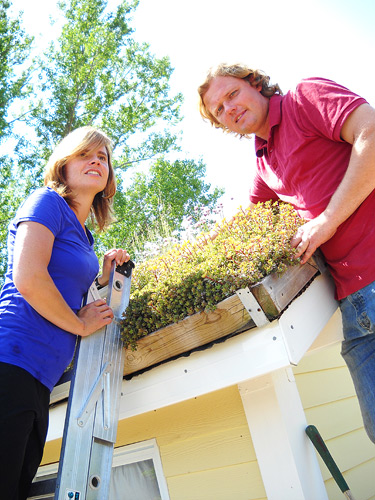
Whoever wrote U of G’s tagline might have been thinking of husband-and-wife couple and Guelph entrepreneurs Mathis Natvik and Satu Repo-Hendsbee. He’s a landscape design consultant also pursuing a master’s degree in landscape architecture; she’s a practising psychiatrist and part-time U of G master’s student in rural planning. Their respective studies ― his tinted green, hers flavoured with health and well-being ― have “Changing Lives, Improving Life” written all over them.
Says Maurice Nelischer, director of the School of Environmental Design and Rural Development (SEDRD): “In many ways, they are doing restorative environments. Mathis is restoring our urban environment by addressing water runoff, pollination, cooling, heating and wildlife habitat. Satu is looking at restoring our health, both mental and physical.”
Natvik studied ecology at Guelph for his undergrad degree, completed in 1997. His conservation roots go back to childhood on a mixed organic grain farm near Ridgetown, Ont. There, his family has restored about one-third of the acreage to Carolinian woods, meadows and wetlands. Much of that work involved Mathis, who viewed the 365-hectare farm as a test bed for his first experiments with green roofs, prairie restoration and gardening with native plants.
In 1999, he opened a nursery providing native plants for ecological design projects. Natvik Design Inc. designs and installs green roofs, gardens and ecological restoration projects. The company has installed green roofs on homes and public buildings throughout southern Ontario, including the downtown YMCA in Toronto, the Activa sports complex in Kitchener, and the Denso Manufacturing plant and Delta Hotel in Guelph.
At his Guelph home, Natvik planted demonstration roof gardens atop two backyard tool sheds, with such drought-resistant cultivars as sedum, chives and cactus planted in custom boxes containing his soil mix ― a secret recipe, he says.
He might have included a green roof in extensive renovations to their 1940s bungalow, but the house couldn’t have taken its weight. Instead, he installed a recycled aluminum roof, along with recycled concrete siding and recycled plastic for the front porch and stairs. Referring to LEED green-building ratings, Natvik says, “This building would score platinum.”
The entire 100-metre-deep property serves as a “mini-farm” and nursery for his business. It’s also a demonstration site, with a rain garden in the shaded front yard and a developing prairie garden out back. His gardens, trees, shrubs and perennials allow Natvik to test out plants and ideas for client projects.
He’s restored native Ontario landscapes, including planting oak savannah, prairie gardens and even a wetland for stormwater management at a Cambridge housing development. Also in Cambridge, he planted a tallgrass prairie meadow for research by integrative biology professor Andrew MacDougall. Back in Guelph, Natvik will plant and maintain a new pollinator meadow planned for the former Eastview Landfill site.
He began master’s studies two years ago, looking to gain accreditation and, he says, “to bridge the gap in knowledge between landscape architecture and ecology.” Prof. Karen Landman, SEDRD, considers him as an asset to the school’s grad program.
“He starts talking, and you’re overwhelmed by how much he knows about our local ecology,” says Landman, who is helping to plan the Eastview pollinator park. “It’s important for students to understand local ecology in their design work.”
Landman also helped point Repo-Hendsbee to departmental colleague Prof. Harry Cummings, after the would-be student had called to inquire about her own grad studies. A psychiatrist interested in eating disorders and addictions, Repo-Hendsbee has begun practising this month at the Guelph General Hospital.
She’s also begun that part-time degree in rural planning. “I am interested in how the built environment influences health and emotional well-being.”
Some of that interest stems from the couple’s company. Many clients are interested in green design, but too few consider possible human health benefits for communities, workplaces or institutions, she says, whether in rural or urban settings.
Consider something as seemingly simple as the intersection near their home, where she says nearby construction diverted traffic this spring, with several near-accidents. Or take the two seniors’ residences nearby where Repo-Hendsbee regularly sees people with walkers trying to beat the traffic lights. She’s interested in designing complete neighbourhoods that provide everything you need within walking or transit distance from home.
Contrasting her studies with her patient-focused practice, she says her planning degree is “a larger-scale approach to health and medicine.”
Indeed, her interests reflect a wider move to link landscape architecture and rural planning, says Cummings. “We’re working with our landscape architecture colleagues to try to improve community design, to improve the health of communities holistically and to improve the health of people living in communities.”
It’s about “new urbanism,” with houses, jobs and services designed to fit within more walkable neighbourhoods, he says, adding that the model also includes the local food movement. The emphasis in that model for health professionals like Repo-Hendsbee is preventive health.
Says Cummings: “The link to community planning to prevent health issues is a natural one for psychiatrists because you’re trying to find ways to change behaviour. You’re changing the roots of behaviour.”